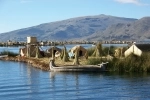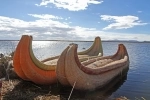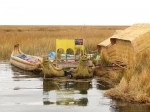Titicaca lake. Puno - PERU
Direccion:
Frontera entre Peru y Bolivia Lake Titicaca extends along the border between Peru and Bolivia and is one of the largest lakes in South America and the highest navigable body of water in the world.
Lake Titicaca has an area of 8562 km? of which 56 is in Peru and 44 in Bolivia. It is at an average altitude of 3812 meters above sea level.
The average annual temperature of the lake is 13 ? C, while the climate in the lake region is extreme in nature, with large temperature variations that are accentuated according to the remoteness of the lake and increase in height. Rainfall increases in the southern summer months (December to March) and falls dramatically in the winter months (April to November). In summer there are frequent storms over the lake and the surrounding area, as well as flooding in level 0 areas over the lake.
The fauna is mainly composed of diving ducks, the Andean cat, tiki chulumpi, guallatas and parihuanas. Among the fish stand out the suche (Trichomycterus rivulatus), and several species of orestias, among the best known are black carachi, yellow carachi, white carachi, dwarf carachi, gringo carachi, ispi, and fish from other families such as mauri ( Trichumectarun dispar) and introduced trout and silverside species.
Among the fish that are extinct due to overfishing and introduction of inappropriate species are the vogue and the umanto.
The main islands in Lake Titicaca are:
Floating Island of the Uros: Located 30 minutes by boat, from the shores of Lake Titicaca, the Uros are a floating island known for being built from totora, a reed that grows under these waters. Inhabited by Aymara, this place is considered one of the oldest Andean civilizations, having emerged long before the Incas. This area grows economically due to fishing, bartering and even their own handicrafts, they also have extra income thanks to tourism.
Taquile Island: Taquile is known worldwide for its textile work. It is the perfect place for trekking, having a staircase of 567 steps to climb to the top of the town. The island is inhabited by Quechua speakers who still perform bartering, an action that involves exchanging one product for another. However, agriculture, textile work and handicrafts are its main economic source.
Amantan Island: Known as the "island of love", Amantan has majestic fields, eucalyptus trees and flowers the song that grows in the highlands. This island is the largest of Lake Titicaca and is three hours by boat, from the city of Puno. Being an isolated town, residents and travelers move from one place to another on foot, since there is no means of transport such as motorcycle or taxi.







